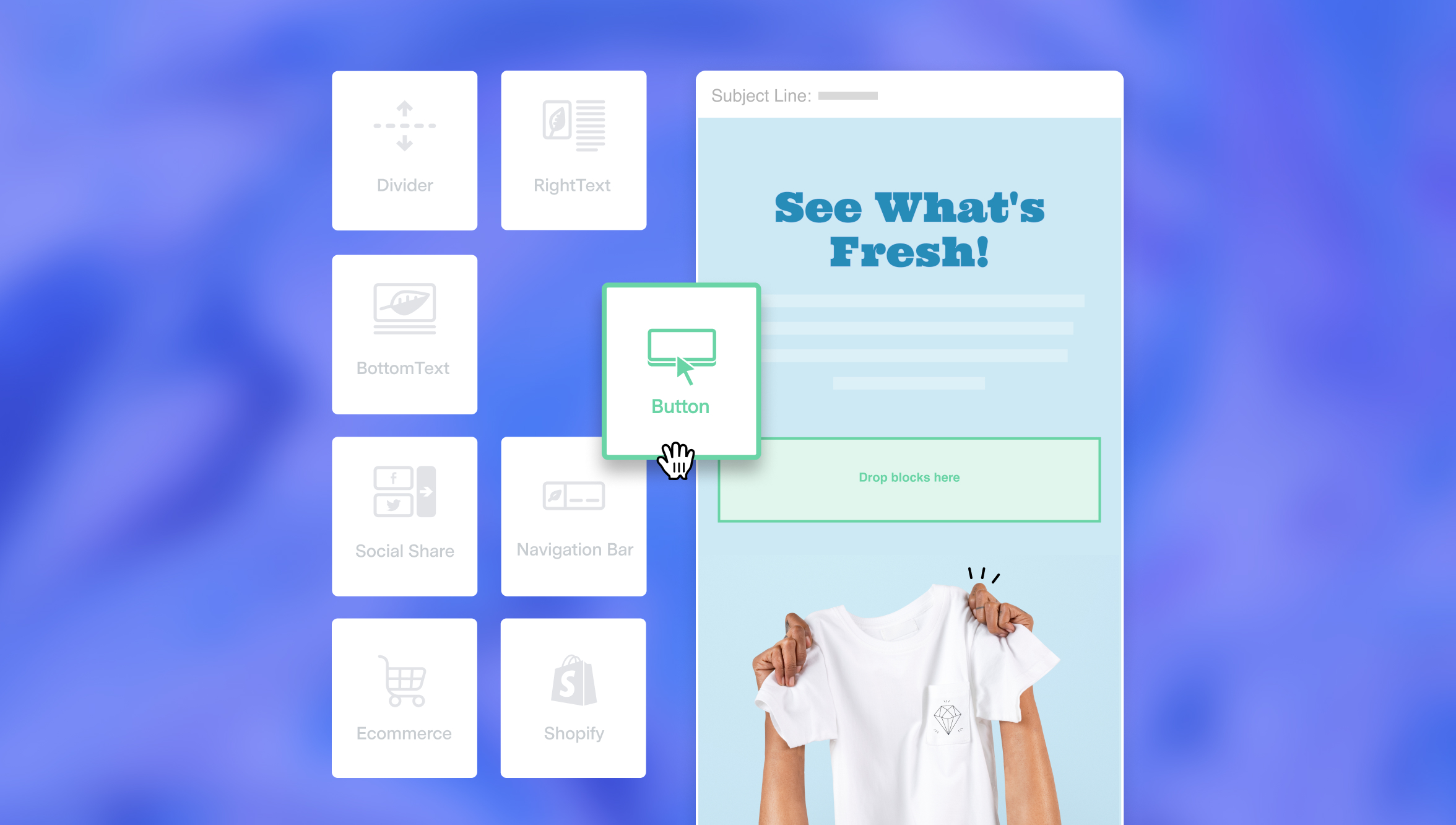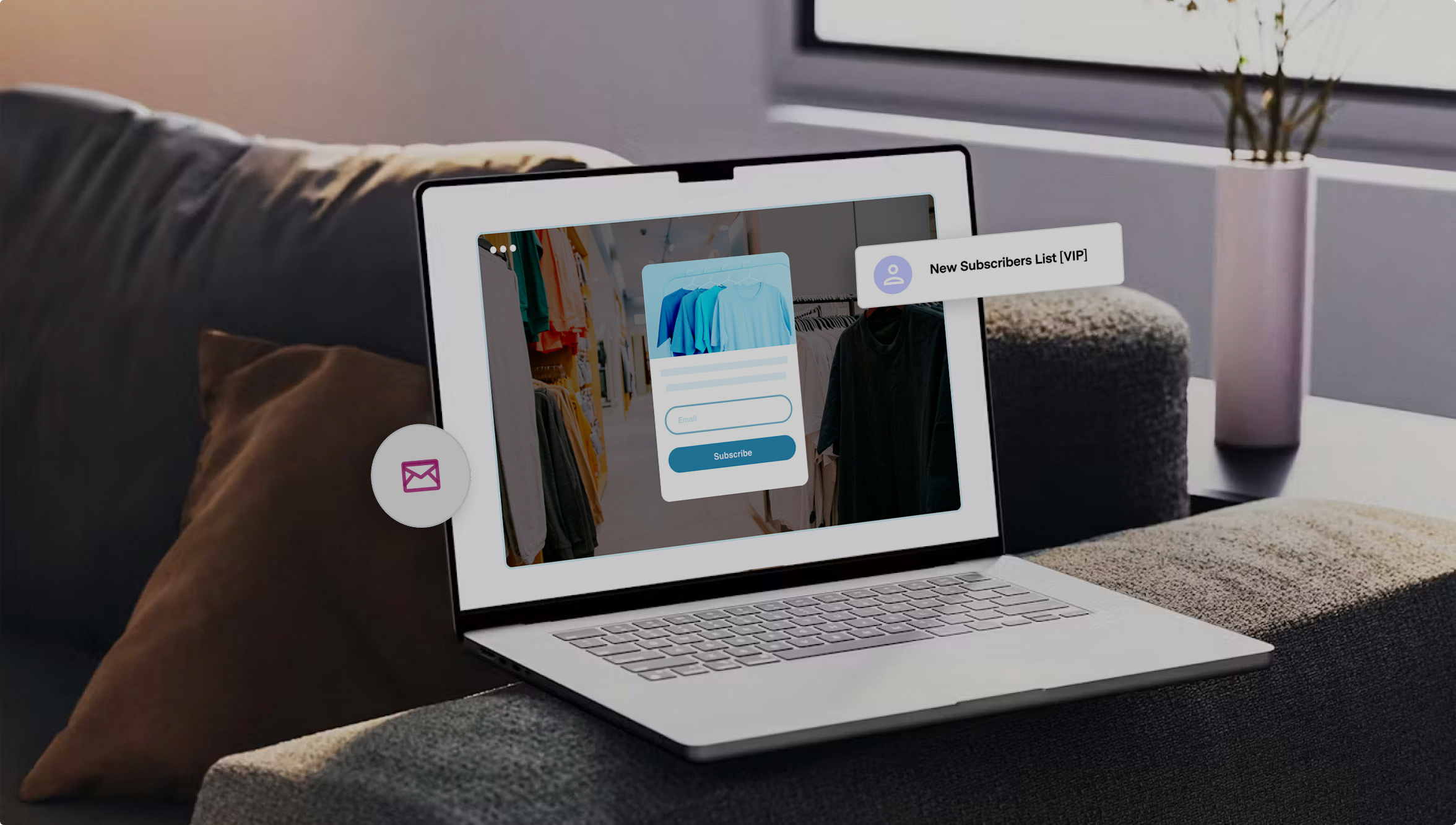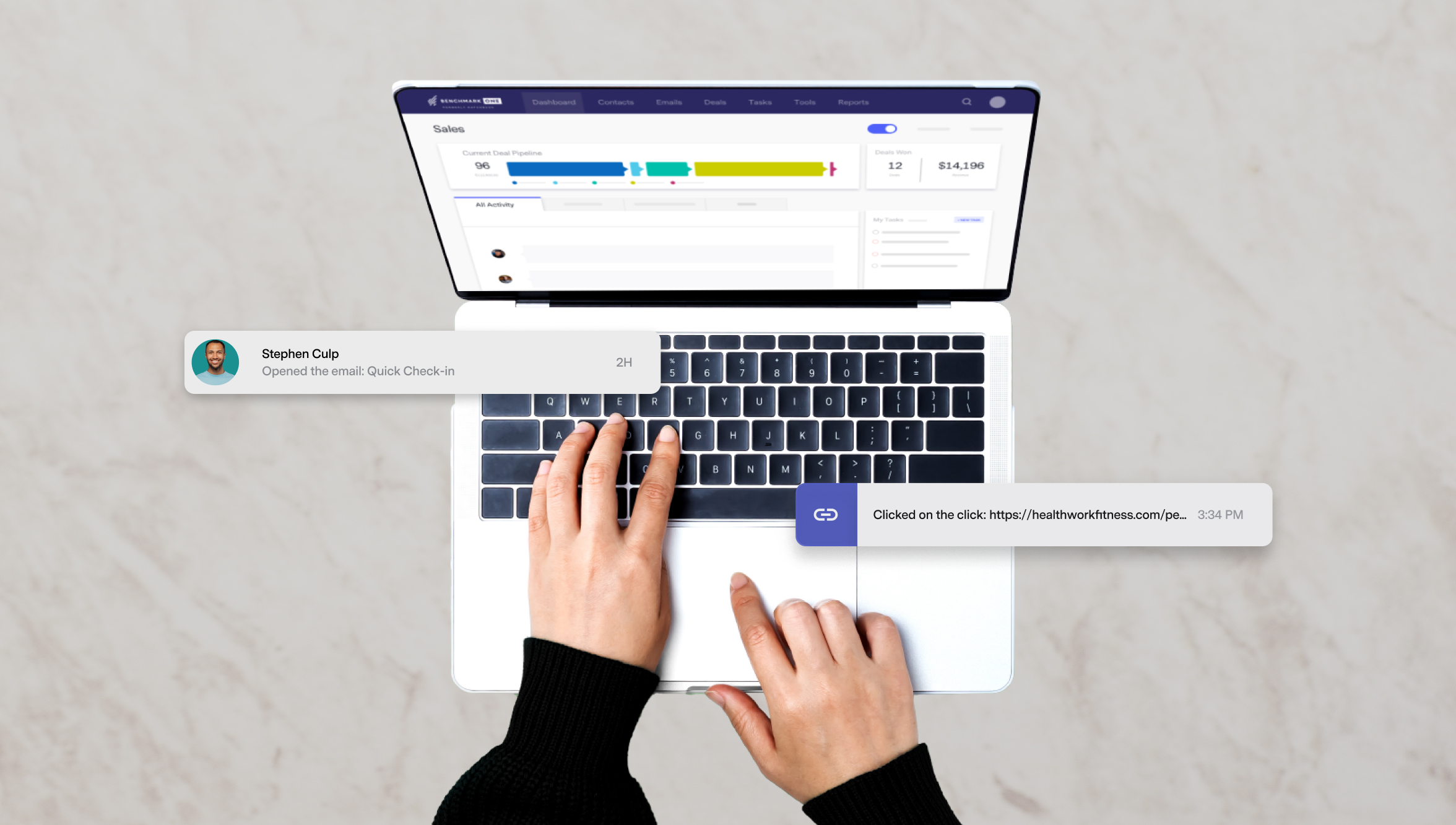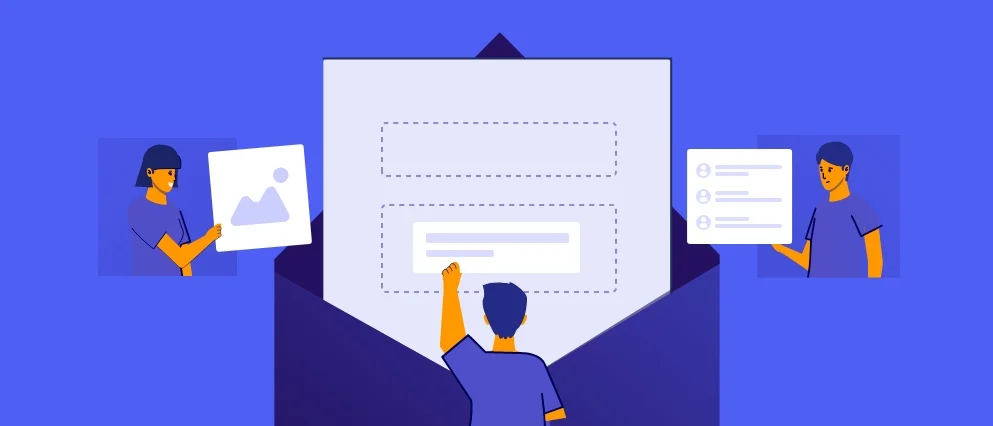Table of Contents
platform and send your first 
The Email Marketing Guide for Agencies
We personally believe that email marketing is a powerful and influential channel for agencies, and with good reason. The cost-effective platform helps you generate high-quality leads and engage existing customers to drive high-profit margins while expending a minimal marketing budget. Done well, email marketing for agencies delivers an average of $36 for every dollar spent.
The marketing world is vast. Whether you’re a social media, web design, adWord/PPC, SEO, or full-service digital marketing agency, you should be getting such ROI or even higher. However, achieving such stellar results is easier said than done.
In this guide, we’ll show you how to rise above the barriers of email marketing for agencies. Keep reading to learn how you can use email to turn leads into customers and existing clients into brand loyalists.
The Value of Email Marketing for Agencies
92% of agency marketers claim email marketing is pivotal to the success of their overall digital marketing strategy.
Why Email Marketing Works
Email is noninvasive
When customers subscribe to your email newsletters or agree to hand in their email addresses, it’s of their own will.
They give you a way into their inbox, hoping to get value in return. And as long as you keep meeting their expectations, the relationship will continue to be mutually beneficial.
Email puts the control in their hands
Email marketing is rooted in education and providing resources so buyers can make better,
more informed decisions. It gives more control to your subscribers than other types of marketing.
Email marketing maintains brand visibility
Email keeps your brand top-of-mind with your subscribers because you’re able to maintain consistent touchpoints with them.
Email offers direct contact with customers
You have a direct line to your customers’ inboxes, where you won’t have to compete for their attention as much as you would on other channels.
How Agencies Can Leverage Email Marketing to Build Relationships
Email can help you build a steady flow of income for your agency. However, to tap the full potential of this channel, you have to build long-lasting relationships with your customers.
How?
One way is to build targeted email campaigns to create consistent outreach that nurtures. Your clients didn’t sign up for your email list to feel part of an “email blast.” The fact that they gave you their email is not a permission slip to pester them with constant sales pitches and links.
Your customers gave you a line to their inbox hoping to get specific and actionable messages that match their goals and preferences. To that end, you should personalize each email campaign to the client’s intent, interest, and needs.
Doing so opens up an opportunity to build mutual connections, foster real trust, and establish proper brand relationships. When clients trust you they engage more with your emails and unsubscribe less from your email list – which is a huge win in the email marketing realm.
How Agencies Can Leverage Email Marketing to Build Relationships
Besides helping customers build a relationship with your brand, email gives you tons of options to convince prospects to buy your agency services. Email marketing lets you build a foundation of trust because you’re:
Touching Base Consistently
There is a range of touchpoints at which you can interact with customers. For example, you can send a welcome series to give new subscribers their first marketing email from your brand, and an ideal first impression.
You could send a news alert to notify customers of an impending Google update and advise them how to prepare. Reaching out at multiple touchpoints shows that you care and your fingers are on the pulse of changing digital marketing – meaning they’ll trust you and potentially spend more.
Sharing Valuable Resources
Regularly share helpful resources, like eBooks, whitepapers, and guides to help position your agency as a subject-matter expert.
Spreading Education
Similarly, educational emails that share articles, how-to videos, and infographics that resonate with your customers remind them you’re the go-to expert in your field.
Soft Selling
When you include different calls-to-action in your emails at each phase of your customer journey, you’ll increase your odds of generating conversions without seeming too “pushy.”
Beyond that, email marketing can boost customer retention, which is crucial for your agency because attracting new customers costs five times as much as keeping an existing one. Here are examples of customer retention emails:
- Thank you and appreciation emails
- Early-bird offers for launches
- Timely emails for anniversaries and birthdays
- Surveys, promos, and special offers for VIPs
Email Marketing Strategy: A Step-By-Step Guide for Agencies
Here’s a guide that outlines an email marketing strategy we recommend for agencies that are getting started or want to boost their revenue using email.
1. Define Your Goals
Outline your agency’s goals along with specific timelines. Assign a measurable action item or key performance indicator (KPI) against each of these goals. This will help track progress and tweak your email marketing procedures where necessary to remain on course.
Here are some examples of email marketing goals, and KPIs to track for each:
Increase your CTR
The click-through rate tells you out of all the people you emailed, how many clicked on a link in your email. This is a good metric to track, especially if your campaigns center on a specific promotion and you’re wanting to see how successful you are at enticing recipients with that promo.
Boost open rate
A lot of people rely on open rate to determine success, however, Apple’s iOS15 release has made this metric somewhat unreliable. Just keep in mind that if you’re using open rate to track email marketing success, you should also be tapping into other metrics for a more accurate temperature.
Reduce bounce rate
Bounce rate is the number of emails you send that never make it to the recipient. While this isn’t ideal, it’s not a metric that should be a sole indicator of success. This is something to keep an eye on and if it gets out of hand, it’s wise to look into any practices that could potentially be hurting your deliverability.
Increase revenue generated
Track conversions and sales related to your emails in order to see how well your email marketing is contributing to your business growth.
Improve customer retention
If your main focus is on your retainer business, pay special attention to how your email marketing contributes to customer retention. For example, create a campaign that notifies users or customers that it’s time to renew their contracts, or offer existing customers a discount on referrals.
2. Identify Your Target Audience
You’re likely already aware of your target audience, but for the purpose of your email marketing strategy, it’s important to hone in on your ideal customers so you can segment your email list and create content that really speaks to your subscribers.
Build out buyer personas of your archetypal customers. This should be a data-backed process to determine your ideal customer and define them by their:
- Job title
- Industry
- Company size
- Department size
- Who they report to
- Main issue they need solved
- Region/location
3. Grow Your Email List
Building an email list is based on a simple exchange. You create content your potential customers like or give them an irresistible offer to convince them to share their email addresses with you.
There are many ways to grow your email list, including:
Paid advertisements
Use LinkedIn ads, Google AdWords, or Facebook ads to drive traffic to your landing pages, website forms, and opt-in forms. These sources of paid traffic are an effective way to grow your email list, but require a sizable budget to test and track results.
Gated content
Do you have an industry report, whitepaper, or thought-leadership piece that is helpful to your target? Gate that content and ask the reader to provide their email before they can access it. If the content is targeted and solves the audience's most pressing problems, they won’t hesitate to opt-in to your emails in order to get it.
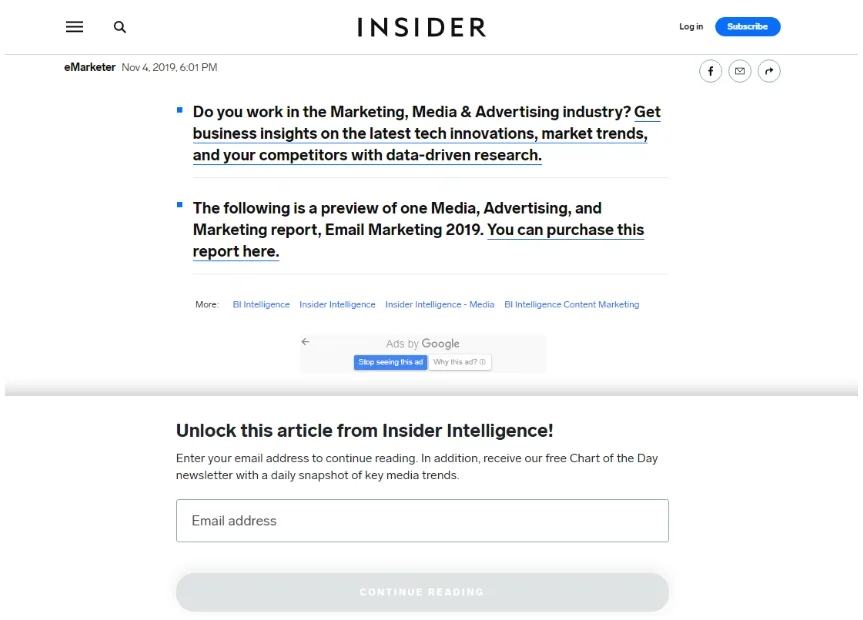
Lead magnets/landing pages
Place your lead magnet offer behind website forms, opt-in forms, or optimized landing pages and drive website traffic from other sources, such as social media, to the offer.
If you’re having trouble growing your email list, make sure you tap into various tactics to help you take advantage of your high-traffic pages and get creative with how you drive traffic to those pages.
4. Segment Your Email List
Gavin Laugenie, Global Head of Content at DotDigital, opines that “customers want to get a personalized experience from the brands they choose to share their personal information with.”
If you offer personalized experiences, 80% of customers will purchase from your agency. But that’s not all. Personalized email marketing delivers an ROI of 122%, which is almost 100% more than the second-placed channel, social media.
How effective your personalization is comes down to proper email list management, primarily segmentation. Email list segmentation means grouping subscribers with similar traits in one cohort. You can choose to build subscriber segments based on:
- Purchase history
- Website behavior
- The buyer’s journey
- Geographical location
- Industry or role-based
Set your email strategy up so that new signups will automatically fall into specific based on qualifying factors you’re able to gather on them, be it specific actions they take on your site or from the emails you send them. Continuously update customer information with zero-party, first-party, and third-party data (while you can) to build robust profiles. This goes a long way in helping you keep up with changing customer needs and interests so that you can always deliver a personalized experience.
Lastly, keep your email list fresh and active. In other words, prune your email list regularly to weed out inactive addresses to improve email deliverability.
5. Create Your Email
List Types of Emails You Want to Send
Decide on the types of emails you want to send. If you’re just getting started, here are some common emails to consider sending your subscribers:
- Welcome emails
- Newsletters
- Promo emails
- Content marketing emails
- Drip campaigns
In addition to these emails, agencies looking to grow their retainer business should launch campaigns geared towards retention and expanding on existing relationships.
Establish Email Design
An email design that works for promotional emails might not suit your newsletter series. Pick a design with a layout, graphics, call-to-action (CTA), branding, and creative content to fuel your campaign goals. Your design should:
- Resonate with your audience and make the most of the few seconds you get in their inbox.
- Utilize white space and visual components harmoniously.
- Capture the subscriber's attention. If the subscribers like what they see, they'll be intrigued to read and take the necessary action.
- Engage the subscriber with language that speaks to them.
Here’s an example of a well-designed email:
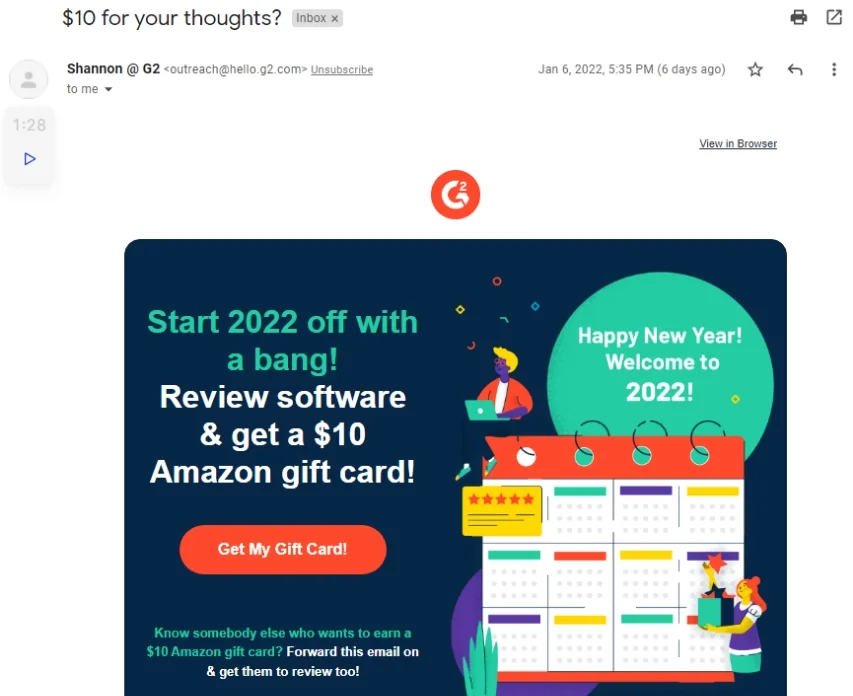
The email is simple and straight to the point. The subject line is clear about what’s in it for the reader and the content is concise, with no blocks of text to bore the reader. The sender uses visuals to grab the reader's attention and adds a CTA button with contrasting colors to make it eye-catching.
Benchmark Email’s email templates enable you to create beautiful emails without knowledge of HTML. There's a list of pre-configured email templates for different campaigns, industries, and formats.
Automate Email Processes
Once you create your email, send out a few campaigns to test the waters. Brands that A/B test their emails improve their email marketing ROI by 16%.
Do A/B testing to see what’s working and what’s not. Test email subject lines, CTAs, visuals, and more to find out which design delivers the best results. Refine your process over time and add autoresponders and workflows to capitalize on as many opportunities as possible.
Refine your process over time and add autoresponders and workflows to capitalize on as many opportunities as possible.
Autoresponders
are automatic emails sent to a customer when they perform the desired action. For example, when a customer signs up for your newsletter, you can set up a welcome email autoresponder.
Email workflows:
Send a series of emails to subscribers based on their behavior, preferences, or contact information. The emails are often geared towards making a subscriber take a predetermined action, like purchasing a service.
6. Track Performance
Once your email campaigns are up and running, it’s time to measure results and track progress.
You already know which KPIs or metrics to track based on your email marketing campaign goals. With software like Benchmark Email, all these metrics are accessible on a centralized reporting dashboard. This makes it easier to track progress and adjust your campaigns as you learn what works and what doesn’t.
Select Your Email Marketing Tool
In the marketing world, email marketing software is a must-have if you want to get the most out of your email strategy. Benchmark Email provides all the features you need to launch, monitor, and manage successful campaigns, including:
Pre-designed email templates:
Customizable email templates act as a springboard for ideas and expedite the email design process.
Email A/B Testing:
We support A/B split testing to help you unearth winning email send times, copy, and CTAs.
Marketing Automation:
Our automation pro will help your agency drive more revenue based on user activity and automated triggers.
Reporting:
Tap into your open rate, bounce rate, unsubscribes, which links are being clicked (and by who) and more with our helpful reporting.
Lead generation and email list-building features:
The whole idea of running email marketing for agencies is to drive sales and close leads. We give you lead generation features, like website forms and landing pages, to fuel growth with minimal effort.
Integrations:
Our long list of integrations allows you to use tools you’re most comfortable with using in conjunction with Benchmark Email so you can continue to be as productive and strategic as possible.
Ace Email Marketing for Your Agency
Hopefully, our ultimate email marketing guide for agencies guide has given you a comprehensive solution for incorporating email into your marketing playbook.
A solid email marketing strategy requires an equally feature-rich email marketing tool to deliver the desired results. Benchmark Email ticks all the boxes for new and established agencies alike, and with the help of our software, you can get a first-hand feel of what email marketing can do for your agency. Sign up for free today!
